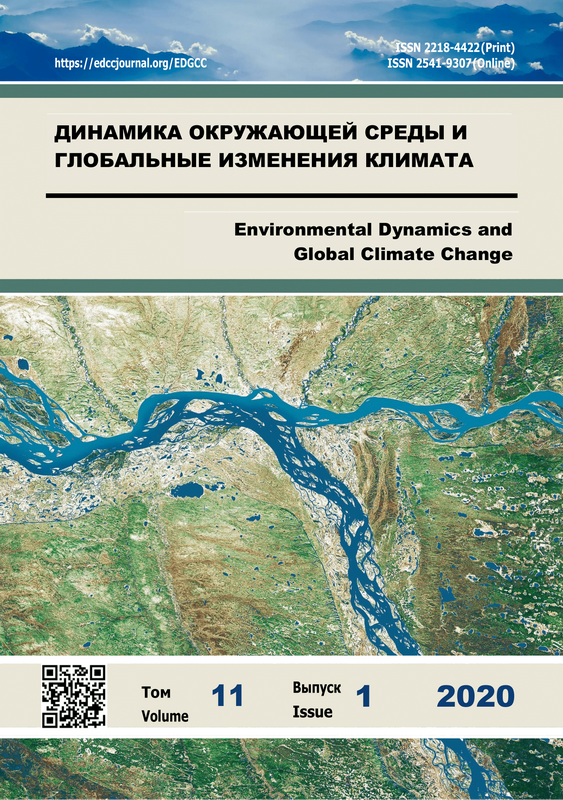Том 11, № 1 (2020)
- Год: 2020
- Выпуск опубликован: 20.05.2020
- Статей: 6
- URL: https://edgccjournal.org/EDGCC/issue/view/1940
Обзоры и лекции
Systems approach to the study of microbial methanogenesis in West-Siberian wetlands
Аннотация
This work is a lecture adapted to the format of a journal article on the course "Modern Topics in Biology", delivered by one of the authors in Yugra State University.
The modern stage of the development of science and biology, in particular, is characterized by a systematic approach to the evaluation of various phenomena. In the concept of hierarchical holism, which dominates the systems approach, various biological systems form a hierarchical structure in which an element of one system is an independent system of a lower level. In any individual system, the key points are the interaction of its components and the structure that determines the stability of the system. The microbial systems of wetlands in West Siberia play a crucial ecological role in the context of the problem of greenhouse gases and changes in climate and atmospheric composition. The greenhouse gas methane entering the atmosphere is formed by the methanogenic microbial community, which is a complex biological system containing microbial groups which are closely related to each other by trophic interactions. The result of the work and the efficiency of the methanogenic microbial community is also determined by various physicochemical parameters of the environment. The main microbial agents responsible for the production of CH4 are methanogenic archaea, which are divided into three main trophic groups. The application of a systematic approach to the study of the methane cycle in wetlands of West Siberia allows us to comprehensively evaluate the vertical and horizontal system relationships, identify key elements and conduct a complex analysis of the problem under study.
 53-68
53-68


Теоретические работы
Land cover features of the pool of river Polia of the eastern slope of the Subpolar Ural
Аннотация
The article considers the natural conditions, landscape, floristic and phytocenotic features of the territory of the Poli river basin of the eastern slope of the Subpolar Urals. A historical overview of geographical studies of the area is given. The main components that affect the formation of landscapes are characterized. A landscape map of the region under study is proposed. Particular attention is paid to the characteristics of rare plants observed in this territory. The necessity of isolating the study area as a natural monument is substantiated.
 4-15
4-15


Annual range of temperature and precipitation forecast for Altai-Sayan mountain country
Аннотация
Разработана методика статистического прогноза среднемесячных температур приземного слоя воздуха и месячных сумм осадков на год вперед для горных территорий. Методика основана на адекватном описании помесячной динамики этих факторов в процентах от их среднемноголетних месячных значений in situ. Такая динамика одинакова для всех участков территории, независимо от их высоты и экспозиции. На примере Алтае-Саянской горной страны показано, что для прогноза достаточно данных наблюдений нескольких реперных метеостанций за шесть-семь лет. Предложен универсальный критерий для определения качества различных прогнозных методов, включая те, для которых известные показатели RSR и Нэша–Сатклиффа не применяются. С его помощью оценено качество выполненных прогнозов температур и осадков, которое оказалось близким к теоретически наилучшему.
 16-23
16-23


Экспериментальные работы
The reaction of the environment to climate change in the Northern latitudes (on the example of the taiga zone of the Khanty-Mansiysk Autonomous Okrug-Yugra)
Аннотация
В статье изложены некоторые результаты исследования влияния современного изменения климата на природную среду в условиях таежной зоны Ханты-Мансийского автономного округа-Югры. Приведены многолетние показатели средней годовой температуры воздуха и продолжительности залегания устойчивого снежного покрова по данным некоторых метеорологических станций региона. Определена реакция природной среды на основе анализа фенологических процессов в условиях изменения климата исследуемой территории. Представлены опасные гидрометеорологические явления, наблюдаемые на территории в ХМАО-Югры.
 24-36
24-36


Decomposition rate of peat-forming plants at the initial stages of destruction in peat deposits of the oligotrophic bogs “Bakcharskoe” and “Timiryasevskoe”
Аннотация
В статье представлены экспериментальные данные по разложению растений-торфообразователей на начальных стадиях в торфяных залежах олиготрофных болот с разными гидротермическими условиями. Дана количественная оценка скорости разложения основных видов-торфообразователей; определена динамика содержания общего углерода, азота и зольных элементов; проведен микробиологический анализ. Выявлено, что наиболее интенсивные процессы разложения протекают в первый месяц деструкции, затем скорость разложения снижается. Наиболее устойчивы к разложению сфагновые мхи (потери массы Sphagnum fuscum составляют 9-18% от исходного значения). В целом интенсивнее процессы разложения наблюдаются в торфяной залежи более теплого и менее влажного Тимирязевского болота, в условиях которого наиболее активна микрофлора азотного цикла. Микрофлора, участвующая в цикле углерода в первые месяцы разложения в целом менее активна в отличие от остальных групп микроорганизмов-деструкторов.
 37-48
37-48


Hydrometeorological conditions and water regime of the lake Krasilovskoye (Altai krai) in 2013-2017
Аннотация
Представлены данные мониторинга гидрометеорологических условий и гидрологического состояния бессточного пресноводного озера Красиловское в 2013-2017 гг., полученные с помощью автоматизированного агропромышленного измерительного комплекса (АПИК) и снегомерных съемок. Проанализировано влияние гидроклиматических условий на характер весеннего подъема уровня воды в озере. Величина и скорость подъема уровня в наибольшей степени зависит от температурного режима грунта в предшествующий холодный период. Установлено, что зимой 2014 и 2016 гг. условия холодного периода способствовали промерзанию грунта и формированию «запирающего» ледяного слоя, который препятствовал вертикальной инфильтрации талых вод. Интенсивный сток талых вод вызвал резкий подъем уровня до 1-1,5 метров. В 2015 и 2017 г., когда промерзания грунта не наблюдалось, подъем уровня был существенно ниже, несмотря на значительные снегозапасы и высокую интенсивность снеготаяния.
 49-53
49-53











